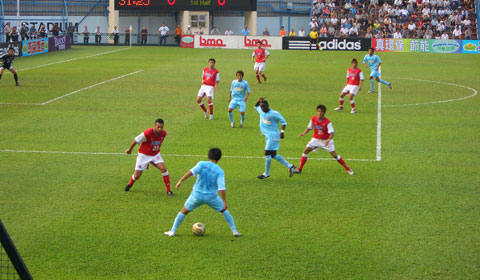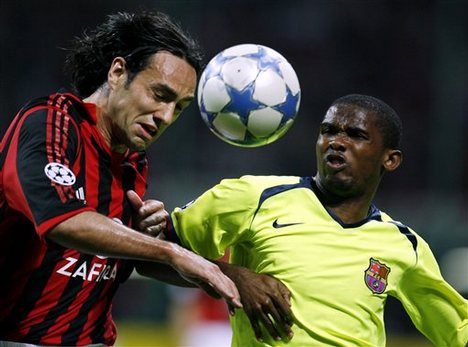-
Recent Articles
The Midfielder as Centerback
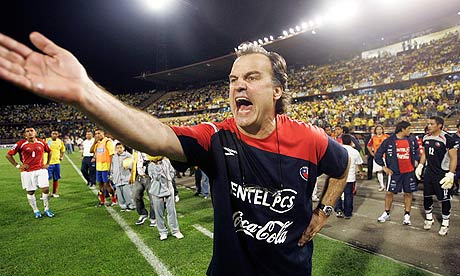 Marcelo Biesla and Josep Guardiola are both managers who play a very high line with their respective sides and who both demand that all players be technically proficient with the ball. Part of playing...
Marcelo Biesla and Josep Guardiola are both managers who play a very high line with their respective sides and who both demand that all players be technically proficient with the ball. Part of playing...Understanding the 4-4-2 Diamond
DEFENCE Despite the fact that there are four ways to play a diamond formation on FM, the differences between them are few and usually subtle. As a starting point, one thing each of them do have...3 at the back and the 4-4-2 Diamond
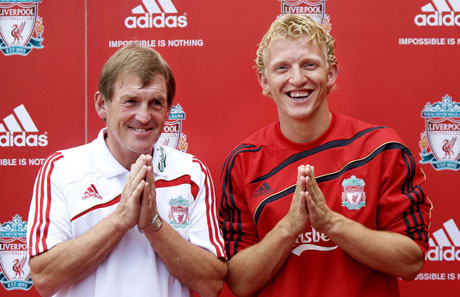 Last week Chelsea v Liverpool became the biggest tactical talking point of the season. Liverpool revived the the 3 man defence that Kenny debuted against Stoke. While with the introduction of Torres for £50m...
Last week Chelsea v Liverpool became the biggest tactical talking point of the season. Liverpool revived the the 3 man defence that Kenny debuted against Stoke. While with the introduction of Torres for £50m...How To Set Up A Back Four
 Last year, I wrote a guide about how to play a simple 4-4-2. One of the major components of that is the back four. In fact, most modern formations build upon four defenders; two full backs and two centre...
Last year, I wrote a guide about how to play a simple 4-4-2. One of the major components of that is the back four. In fact, most modern formations build upon four defenders; two full backs and two centre...Building Your Defence: Full Backs
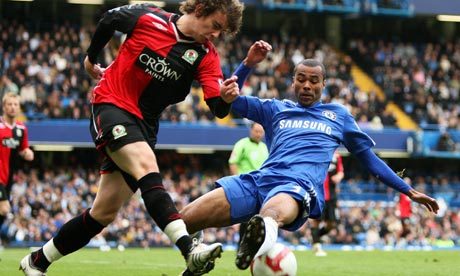 The modern full back is quickly becoming one of the most important players on the team sheet, infact even back in the days of Brian Clough, fat ed' argued that because of the space these players get in the final...
The modern full back is quickly becoming one of the most important players on the team sheet, infact even back in the days of Brian Clough, fat ed' argued that because of the space these players get in the final...
JOIN 1,234 READERS - SUBSCRIBE NOW TO OUR FOOTBALL MANAGER NEWSLETTER
Get the latest FM news & best community content delivered directly to your e-mail inbox!
Defence in Football Manager
Written by: Gareth Millward
Category: Formations
Posted on: October 17, 2007
October 17, 2007
The one response that really annoys those who complain about the game is “it’s your tactics”. And, to be honest, so it should. “It’s your tactics” doesn’t solve anything. Of course, regulars around the community know the full meaning of this little epithet, but most newcomers (I deliberately avoided the term ‘n00b’), find it rather offensive - the mantra of the geek defending the game but not actually answering the problem.
“It’s your tactics” is therefore usually expanded, especially on tactics boards. We tend to add extra clauses to the law. The favourite one at the moment appears to be “It’s your tactics - look at how you’re conceding goals”.
It occurred to me recently, however, that this phrase in itself is useless unless you know how to look at how you’re conceding goals. It might sound obvious - you may even think you know all the answers - but a lot goes into a goal. Did the poor marking on the striker cause the goal, or was it the fact that the winger was given all day to place a perfect cross? Or was it even simply the fact that the opposition were given enough time to cooly pass it around until the striker was poorly marked?
I have tried, therefore, to outline a very basic set of guidlines for analysing those pesky “goals against” scenarios. Hopefully, it may give a little more flesh to what is obviously a very true but very useless statement - “It’s your tactics”.
In my opinion there are three main elements to a goal. In reverse order:
- The goal scorer - the guy that actually puts the ball in the back of the net
- The supply - how the goalscorer was able to be in the right place to put the ball in the back of the net
- The build up - how the team managed to get to the right situation for the final few moves of the attack to be effected
The third one is the most difficult to read and to judge. So, for now, we’ll leave it and concentrate on the two which are easiest to spot (or at least, the ones which usually receive the most attention from fans and commentators).
1 - Mmm, goooooooooooooooooooooooooool!
The striker may have scored the goal, but how did he score it? From where? Who was around him? Did he use his head or his foot?
Questions like this may seem obvious, but the obvious answers are sometimes the most overlooked. If your team tend to concede a lot of headed goals, then perhaps it is time to invest in a taller player or two in key positions. If your team concede a lot of close range shots, consider how the opposition are able to get so close. If there are a lot of long-range shots being scored, is there a problem with your keeper, or are you blocking his view with defenders or perhaps deflecting it too much? Is there a marking issue? Or are too many challenges being missed? Simply, how is the opposition player able to shoot from the place he does, and is it a fault of your team or tactics?
The goal scorer is only a small part of a goal, and his role may only be the split second in which the ball makes contact with his foot or his body, but if you stop him being able to do that you may reduce considerably the number of chances you concede.
Things to consider:
- Is the striker/goalscorer unmarked or poorly marked?
- Did the goalscorer exploit a weakness in his marker (height, strength, tackling ability)?
- Is the shape of the team as a whole a factor (is the player poorly marked because of poor position caused by shape and tactics, or are certain positions outnumbered in attack situations)?
- Is there a pattern emerging accross the whole game or accross the season?
- Would a better (more talented) player/team be able to cope better? Or could the same job be done by concentrating more on the positioning and instructions of the defence?
- Check the shots attempted, shots on target and goals from various positions accross the season. Is there a pattern? Are certain areas of the pitch getting more opportunities than others, and ask yourself both why and how can you stop them.
2 - Beautiful ball in from the left wing…
A little less obvious, but by no means less crucial is the role of the assist. It might be one person, it might be a couple, but in general the goal supply comes from the two or three moves before the goalscorer shoots. You need to look for patterns in supply.
It could be crosses, or brilliant through balls. It could even be that the goalscorer himself is the provider by skinning your defence or by playing a silky one-two with a team mate. In these cases, you can combine your analysis from part one in with part two. At all times you should be considering the importance of the supply, however, since without supply even a world-class striker is nothing.
When people as what type of goal you’re conceding, this is usually what they mean - is it a cross, through balls, free kicks even? Supply is more important, often, than how the ball was actually struck into the net. Crosses can be the result of poor marking on the wings, playing too narrow or simply not being properly positioned to deal with any crosses to the centre (which takes us back to part one and the questions of shape and marking on the goalscorer). Through balls can often be the result of long punts to a striker who beats the offside trap, or shorter ground balls from midfield that the fast striker (or slow, poorly positioned defenders) creates the chance from. Free kicks and corners are also worth considering. Is the supply from the corner the physical act of kicking it from the corner arc, or was it the mazy run that the winger was allowed to make before your right back conceded the corner in the first place? It’s an important thing to consider. If you’re weak at defending corners it’s not necessarily a problem if you never concede them. Consider how changing your tactics might help cover up your weaknesses or may help force the opposition to attack you in a way you are comfortable with.
Finally, while we’re on the subject of supply, remember that your own player might be the supplier. He could be the guy who fouled their captain to give away the penalty, or the dimwit that cleared the goalkick straight at the striker’s face. Either way, don’t forget the mistakes your own players have made as well as the skill of the opposition and ask if it’s just a one off or an avoidable mistake. How can you stop them making the mistake? If not, how can you reduce the potential risks of making the mistake?
Things to consider:
- The physical act of the assist - was it allowed because of poor marking and/or tackling?
- In the run up to the goal, were the opposition afforded too much time, or were they able to exploit you?
- In set piece situations, how was the set piece conceded and is there a pattern? Could you do something about it (lower d-line to stop the defence chasing the game, milder tackling, fewer deflections etc.)?
- Is the supply generally good, or is a combination of not being able to prevent the supply and not being able to stop the supply reaching its intended target? i.e., is the defence poor on both the supplier and the player being supplied (the goalscorer)
- Again, are there patterns of behaviour? Certain types of goals being conceded?
About The Author: Gareth Millward
Member of the FM-B Think Tank and one of the main authors and editors of FM-B’s tactical guides and e-books, Millie organises the content for the main site. He has a particular interest in the history of football tactics (probably because in real life he is an historian) and in recreating real-world football in the FM match engine.
Download Our Tactical Theorems '10 eBook Absolutely Free

Presenting the most comprehensive tactic design and match strategy guide to the Football Manager series ever created!
Written by FM match engine beta testers, it's 60+ pages of easy-to-read concepts and ideologies for getting your team playing exactly how you want each match! It's been downloaded over 100,000+ times to date!
Find out more information about our tactical eBook
and download Tactical Theorems '10 right now!
Written by FM match engine beta testers, it's 60+ pages of easy-to-read concepts and ideologies for getting your team playing exactly how you want each match! It's been downloaded over 100,000+ times to date!
and download Tactical Theorems '10 right now!


